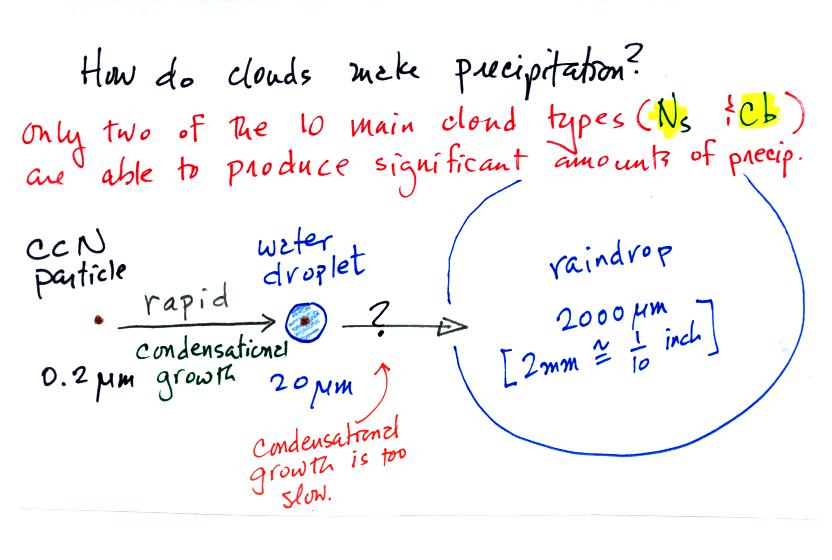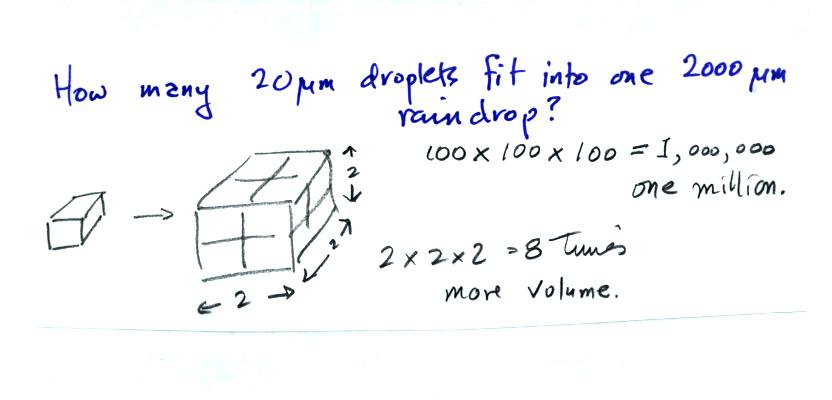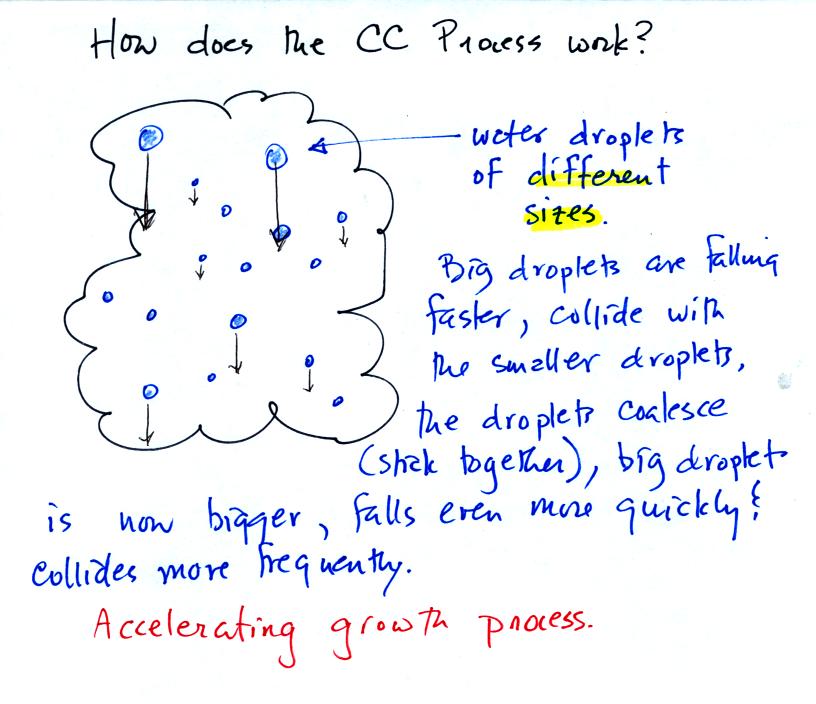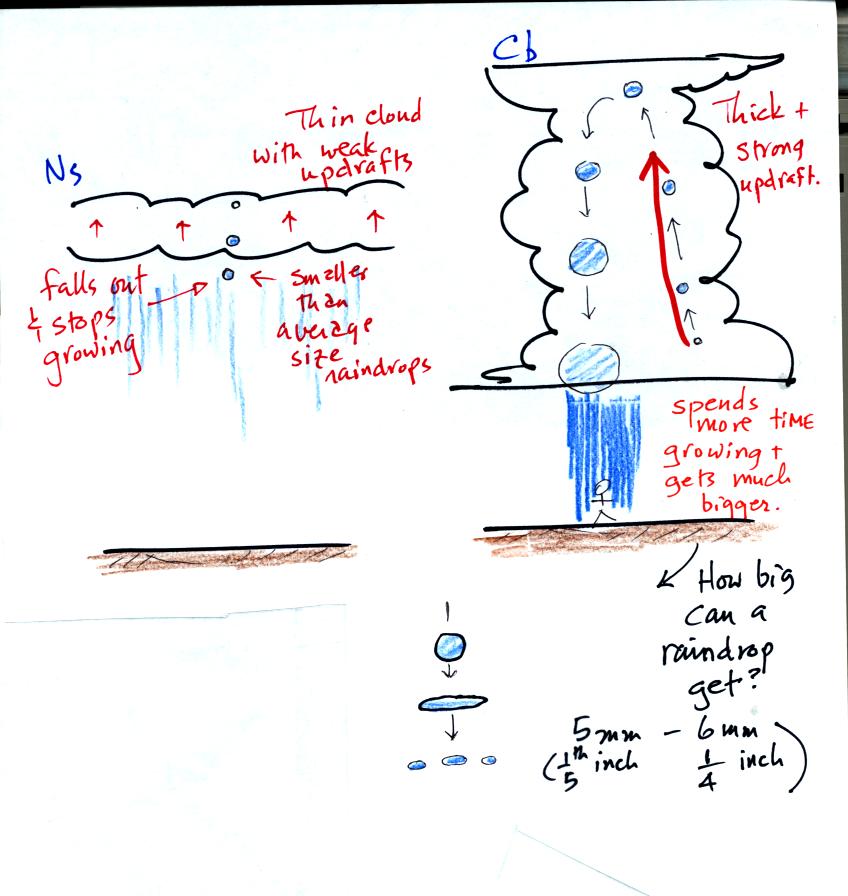Thursday Oct. 26, 2006
Optional Assignments #4 and #5 were collected today.
Answers to the Assignment #5 questions were distributed in class.
Answers to the Controls of Temperature assignment will
appear online (that material won't be covered on the next quiz).
The Atmospheric Stability worksheet has been graded and was returned in
class. There is a link on the class homepage where you can check
to on how the 1S1P Assignment #2 report
grading is progressing.
The Quiz #3 Study Guide has been updated
and is now nearly finished (there may not be any additional changes
made)
Some reading has been assigned from
Chapter 5.
The Experiment #3 reports are due next Tuesday. If you haven't
returned your materials yet, you will now have to come by my office
(PAS 588) to leave your materials and to pick up the supplementary
information sheet. The Expt. #2 revised reports and the
Scientific Paper report are also due next Tuesday.
Today we
will be learning how clouds make precipitation. It's
not as easy as you might think.

This figure shows typical sizes of cloud
condensation nuclei (CCN), cloud droplets, and raindrops. As we
saw in the cloud in a bottle demonstration it is relatively easy to
make cloud droplets. You raise the RH to 100% and water vapor
condenses pretty much instantaneously onto a cloud condensation nucleus
to form a cloud droplet. It
would take much longer (days) for condensation to turn a cloud droplet
into a
raindrop. Part of the problem is that it takes about 1 million
cloud droplets of water to make a raindrop.

A raindrop is about 100 times bigger across than a cloud
droplet.
You must remember that volume depends on length x width x height.
So a 2000 micrometer diameter raindrop contains 1 million times as much
volume as a 20 micrometer diameter droplet.

There are two processes capable of quickly producing
precipitation
sized particles in a cloud.
The collision coalescence process works in clouds that are
composed on water droplets only. Clouds like this are found in
the tropics. We'll see that this is a pretty easy process to
understand.
The ice crystal process produces precipitation everywhere else.
This is the process that makes rain in
Tucson, even in the hottest part of the summer.

The collision coalescence process works best in a cloud
filled with cloud droplets of different sizes. As we saw in a
short video the larger droplets fall
faster than the small droplets. The large droplets overtake and
collide with the smaller ones. The droplets then stick together and
form any even larger droplet that will fall faster than before and
sweep out a larger volume. In this accelerating growth process an
above averaged sized droplet can
quickly turn into a raindrop.
The raindrops that fall from nimbostratus clouds tend to be
smaller
than the raindrops that fall from cumulonimbus clouds. The
growing raindrops don't spend as much time in the Ns cloud because the
cloud is thin and the updrafts are weak.

So how big can the raindrops that fall from cumulonimbus
clouds
get? The answer is about 1/4 inch in diameter.
The
wind resistance that a large drop encounters as it falls through a
cloud causes it to flatten out, start to flop around or wiggle, and
eventually break into smaller pieces.
You may have noticed a few what seem to be very large raindrops hitting
the ground with an impressive splot at the beginning of a summer
thunderstorm. The figure below is one
explanation of this phenomenon.

A bunch of raindrops of different sizes fall from the cloud. The
big ones fall fastest and reach the ground first.
Now we're
ready to tackle the ice crystal process. First though we must
learn something about the structure of cold clouds.

The top of the thunderstorm is so cold that there are just
ice crystals
there. The bottom is warm enough to just contain water
droplets. The interesting part of the thunderstorm and the
nimbostratus cloud is the part that contains both supercooled water
droplets (water that has
been cooled to below freezing but hasn't frozen) and ice
crystals.
This is called the mixed phase
region. This is where the ice crystal process will produce
precipitation. This is also where the electrical charge that
results in lightning is generated.

The supercooled water droplets aren't able to freeze even
though they
have been cooled below freezing. This is because it is much
easier for small droplets of water to freeze onto an ice crystal
nucleus. Not just any material will work, the material must have
a crystalline structure that is like that of ice.
Now what
happens inside the mixed phase region in a cold cloud. You will
find most of the following on pps 101 and 101a in the photocopied class
notes.

In a cold cloud the supercooled water droplets are in equilibrium with
their surroundings. This means the air must be moist enough to
provide enough condensation to balance evaporation from the droplets (3
arrows of evaporation from each drop above is balanced by three arrows
of condensation).
In Step 2, an ice crystal at the same temperature won't sublimate as
quickly as a supercooled water droplet. It is a bigger step to go
from solid to gas than from liquid to gas (see figure below).
There doesn't need to be as much moisture in the air to keep an ice
crystal in equilibrium with it surroundings.

Most of the students in a class would be able to make a 1 foot vertical
jump. The rate of evaporation from a supercooled water droplet is
relatively high because many of the water molecules having energy
needed to evaporate.
Only a few students would be able to make a 3 foot vertical jump, just
as fewer ice molecules will have the energy needed to sublimate.

In a cold cloud ice crystals are found in the very moist air needed to
keep supercooled water droplets in equilibrium. Water will
condense onto the water droplets and be deposited onto the ice crystals
at equal rates (see figure below). The ice crystal will grow
under these circumstances. This is what gets the ice crystal
process started.

Equal numbers of students could jump down the 1 and 3 foot drops, just
as water vapor condenses onto the water droplet and ice crystal at
equal rates.
Once it
gets started, ice crystal process can produce a variety of types of
particles inside the cloud.
We'll look at some of the possibilities next.

Once an ice crystal has grown a little bit it becomes a snow
crystal. Snow crystals can have a variety of shapes (called
crystal habits, sketched above) depending on the conditions
(temperature and moisture) in the cloud. Dendrites are the most
common because they form where there is the most moisture available for
growth. With more raw material available it makes sense there
would be more of this particular snow crystal shape.

Here are some actual photographs of snow crystals (taken
with a
microscope). You'll find even better photographs at
www.snowcrystals.com

A variety of things can happen once a snow crystal
forms. First
it can break into pieces, then each of the pieces can grow into a new
snow crystal. Because snow crystals are otherwise in rather short
supply, ice
crystal multiplication is a way of increasing the amount of
precipitation that ultimately
falls from the cloud.
This is incidentally the idea behind cloud seeding, to increase the
number of ice crystals and hopefully the amount of precipitation.
A substance called silver iodide is often used. Silver iodide is
one of the relatively rare materials that can act as an ice crystal
nucleus. However it is possible to "overseed" a cloud and end up
with too many ice crystals. Then they all fight for a limited
amount of water vapor and, as a result, do not get very big.
Overseeding a cloud could decrease the precipitation from a cloud.

Several snow crystals can collide and stick together to form
a
snowflake. Snow crystals are small, a few tenths of a millimeter
across. Snowflakes can be much larger and are made up of many
snow crystals stuck together. The sticking together or clumping
together of snow
crystals is called aggregation.

Snow crystals can collide with supercooled water
droplets. The
water droplets may stick and freeze to the snow crystal. This
process is called riming or accretion (note it is really the same idea
as collision and coalescence). If a snow crystal collides with
enough water droplets it can be completely covered with ice. The
resulting particle is called graupel (or snow pellets). Graupel
is sometimes mistaken for hail and is called soft hail. Rime ice
has a frosty milky white appearance. A graupel particle resembles
a miniature snow ball. Graupel particles often serve as the
nucleus for a hailstone.

Hail forms in thunderstorms with very strong updrafts.
In the
figure above the hailstone starts with a graupel particle (colored
green to represent rime ice). The graupel falls or gets carried
into a part of the cloud where it collides with a large number of
supercooled water droplets which stick to the graupel but don't
immediately freeze. The graupel gets coated with a layer of
water (blue). The particle then moves into a colder part of the
cloud
and the water layer freeze producing a layer of clear ice (the clear
ice, colored violet, has a distinctly different appearance from the
milky white rime
ice). The particle then can pick up a new layer of rime ice,
followed by another layer of water which subsequently freezes to
produce a layer of clear ice.
Large hailstones can be composed of many alternating layers of rime and
clear ice. An unusually large hailstone (2.5 to 3 inches in
diameter) has been cut in
half to shown the different layers of ice.

















